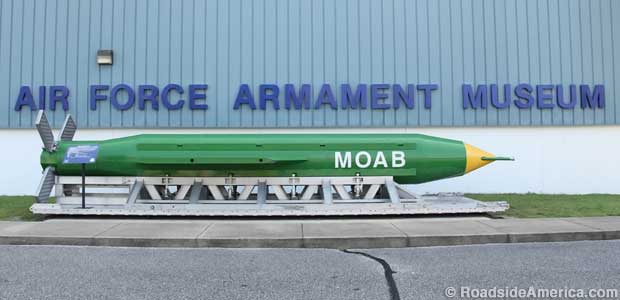
Only MOAB on display anywhere in the world. Can be packed with almost 10 tons of high explosive.
Air Force Armament Museum
Eglin AFB, Florida
"Every day this building shakes," said George Jones, director of the Air Force Armament Museum.
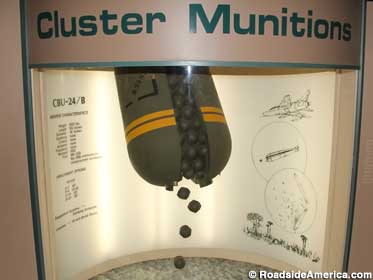
Seed pod of victory: antipersonnel bomblets burst from their carrier container.
Not from earthquakes. From bomb explosions.
How many times does it shake a day? Once? Twice? "All the time," said George.
The museum sits just outside the entrance to Eglin Air Force Base, which is where the U.S. military tests all of its non-nuclear Air Force weaponry, everything from tiny bomblets to the giant MOAB (Massive Ordnance Air Blast), the most powerful conventional bomb ever built. This means, of course, that the museum is not near any centers of population -- you have to drive a ways to get to it -- but where else can you visit a bomb museum with its own sonic accompaniment?
George runs the museum with the pragmatic view of a man who previously spent 26 years as an Air Force munitions officer. "When people say, 'Bombs are bad,' I tell them, 'No, bombs can be good!,' and I show them our sensor fuzed weapon." A museum display from Teledyne, its military contractor, explains it: "Self-forging fragment warheads dispensed from the missile will explosively form and eject a lethal metal slug moving nine times the speed of sound that can punch a fist-sized hole in thick armor from long ranges." The museum exhibits a square of thick tank armor with a hole neatly blown through it. "Danger: Very Sharp Edges," it cautions.
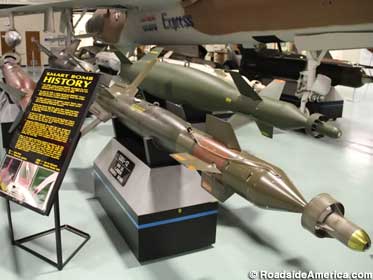
The Bunker Buster bomb helped bring a swift end to the 1991 Gulf War.
"That weapon annihilated the whole front rank of an Iraq tank brigade," said George. "That actually saved lives, because the rest of them surrendered. If it wan't for that weapon, we would have had to destroy the entire tank brigade and more lives would have been lost."
Arrayed around the museum's 28,000-square-foot main hall is a kind of munitions-dispersed history of America's military aviation weaponry, from World War I to the present day. "Eleven years after the Wright brothers flew at Kitty Hawk," an exhibit explains, "men in airplanes were shooting at each other." World War I bombs were simply thrown by hand by their pilots, but by World War II American bombarders were able to "put a bomb in a pickle barrel from 30,000 feet."
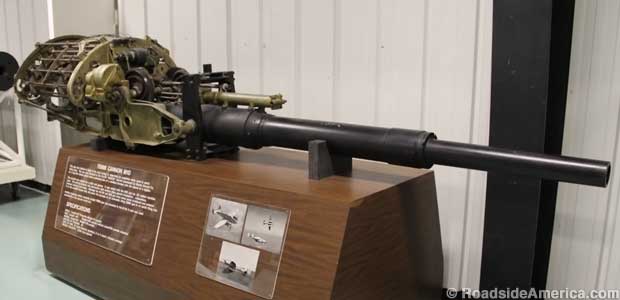
75mm cannon rained justice from above when mounted on airborne gunships.
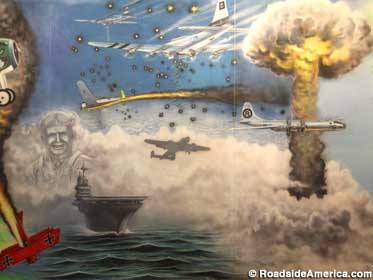
Museum art: ghostly Jimmy Doolittle, flaming enemy, Hiroshima.
An airbrush mural by local artist Mickey Harris provides a left-to-right visual timeline. It begins with one of those bomb-tossing WWI pilots; then the ghostly face of Jimmy Doolittle, whose bomber crews trained at Eglin; then the mushroom cloud of the Hiroshima blast (The museum also has a replica of the "Fat Man" Nagasaki bomb); and finally a modern-day pilot's face mask reflecting "action in outer space." Sprinkled among these graphic markers are the airplanes of American's various historical enemies, going down in flames.
Up in one corner of the museum hall is the cheery yellow "Loon," America's first cruise missile, re-engineered from salvaged Nazi buzz bombs in the waning months of World War II. Drones and rockets hang from the rafters, smart bombs crowd the floor. There are phosphorous weapons, fragmentation weapons, napalm weapons ("effective, but horrific" according to an accompany sign). There are machine guns and aerial cannons, including the GAU-8, which can fire 4,200 rounds a minute. There are CBUs (cluster bomb units), CEMs (combined effects munitions), and CEBs (combined effects bomblets). One directed-energy weapon can invisibly punch holes in moving targets from five miles away (The museum displays a piece of a truck that was blasted this way).
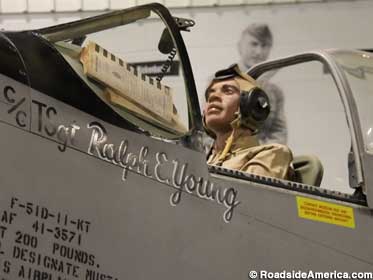
F-51D Mustang and its last pilot, Ralph E. Young.
Possibly the museum's most famous bomb, other than the atomic one, is the Bunker Buster, developed and deployed in record time and "credited with ending the Gulf War," according to its sign. The museum's example is covered with original graffiti, including rude comments directed toward Iraq leader Saddam Hussein. This does not bother most visitors, according to George, nor, in fact, are they disturbed by the weapons, although some have complained about the naughty nose art on the museum's vintage planes.
According to George, the only enemy that can't be defeated by American Air Force munitions is human nature. "All weapons are bad," he told us. "But if I could sprinkle magic dust around the world, and do away with everything from firecrackers to nuclear weapons, do you know what would happen in a hundred years? We'd make them again."
And then we'd build a new bomb-rockin' Air Force Armament Museum so we could look at them again.





